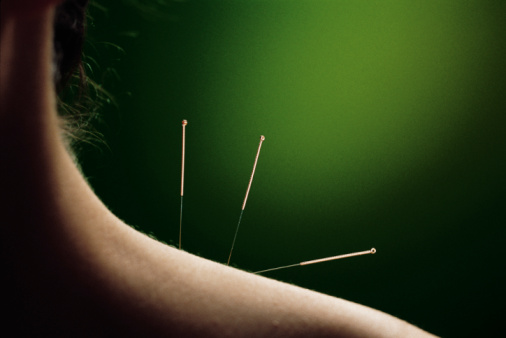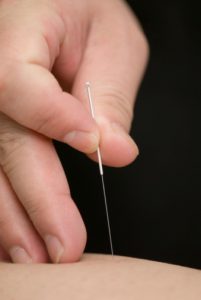 Even though people swear by it, the Traditional Chinese Medicine form of acupuncture is not standing up to the rigors of science and, even according to their own literature, seems to be heading into the realm of mythology.
Even though people swear by it, the Traditional Chinese Medicine form of acupuncture is not standing up to the rigors of science and, even according to their own literature, seems to be heading into the realm of mythology.A recent review conducted by acupuncturists and appearing in the Journal of Acupuncture and Meridian Studies, isolated a new problem with acupuncture that is even more alarming than the fact that the alleged life force energy it is based upon is nonexistent. It now seems that acupuncturists cannot agree on where the acupoints – specific spots on the body where needles are inserted – are located.
“Considerable variation in localization of acupoints was reported among qualified medical acupuncturists. Variation in point location among qualified non-medical acupuncturists is unknown due to lack of any identified study. The directional method was found to be significantly inaccurate and imprecise in all studies that evaluated the method,” the report states.
In other words, in spite of the many charts we see that depict acupuncture points, there is no standard location for these points. In fact, acupuncturists can’t even find them! How can this be when acupuncture is defined as an intervention involving placing thin needles into specified acupuncture points in order to relieve symptoms or promote healing? If the acupuncturists can’t locate the acupoints, how can one expect healing to take place?
Calling this finding another “fatal flaw” in the theory behind acupuncture, Yale neuroscientist Steven Novella, MD, explains, “ . . . [A]cupuncturists cannot agree upon where alleged acupoints actually are on the body, and the primary method to localize them was both inaccurate and imprecise. The simplest explanation for this fact is that acupoints don’t exist. Even if you want to hold out the illogical conclusion that acupoints do exist, even though they have no basis in theory and they cannot be detected by any objective measure, you cannot avoid the conclusion based on this evidence that acupuncturists don’t know where they are. So how, then, can they claim to be able to stick needles into acupoints? Short answer – they can’t.”
This could explain why, after a century of research and thousands of studies, there is still no convincing evidence that acupuncture works for anything.
 For example, Novella, who has subspecialty training in neuromuscular disease, which studies nerve function, discovered early on that there is tremendous variation in nerve anatomy among people. He found that diagrams of typical nerve anatomy were more like schematics than anything else and that it only represented between 60 and 80% of people. “Even when the arrangement is typical (which nerve branches from which other nerve where), the precise location is highly variable from person to person. Anyone trying to find a deep nerve through surface anatomy in order to stimulate it knows how frustrating this can often be,” Novella explains.
For example, Novella, who has subspecialty training in neuromuscular disease, which studies nerve function, discovered early on that there is tremendous variation in nerve anatomy among people. He found that diagrams of typical nerve anatomy were more like schematics than anything else and that it only represented between 60 and 80% of people. “Even when the arrangement is typical (which nerve branches from which other nerve where), the precise location is highly variable from person to person. Anyone trying to find a deep nerve through surface anatomy in order to stimulate it knows how frustrating this can often be,” Novella explains.
“Why, then, would we expect acupoints to be more consistent from person to person? In any case, surface anatomy is highly variable, and there is no way to measure where the mythical acupoints are. Again, you have to retreat to the evidence-free position that acupuncturists can subjectively ‘feel’ them in some way, even though no instrument can detect them. But that position has been destroyed by this review – acupuncturists cannot agree on where they are.”
When one considers the history of acupuncture points, this finding actually makes sense. As Novella discovered, there were originally 365 points which corresponded to the heavenly forces that were thought to be at work in the human body. According to the book, Celestial Lancets: Celestial Lancets: A History and Rationale of Acupuncture and Moxa by Gwei-Djen Lu and Joseph Needham, this was found to be the case since the first half of the first century AD when acupuncturists promoted the belief that the practice’s effectiveness was influenced by the time of day or night, the season, and the lunar cycle. This “science of yin-yang cycles” was based on the belief that curing diseases relied on the alignment of both heavenly and earthly forces that were attuned to the various cycles of the sun and moon.
In other words, “Acupuncture is essentially astrology,” Novella writes.
“How do you imagine ancient acupuncturists derived the location and number of these alleged acupoints? Do you think they did exhaustive rigorous scientific studies? Of course not. Such things did not even exist in the world at that time. At best they did anecdotal observation. But they also had no scientific theory to guide them, no knowledge base of anatomy or physiology. Acupoints are mythology. They were derived in the same way astrological beliefs were – through metaphor and narrative.”
If this is the case, why do so many people profess to having been relieved of pain and nausea after receiving an acupuncture treatment?
The answer to this question is simple. From a neuroscientific point-of-view, it is believed that acupuncture may cause the release of endorphins which are part of the body’s natural pain-control system; by stimulation of nerves in the spinal cord that release pain-suppressing neurotransmitters; or by the naturally occurring increase in blood flow in puncture areas that remove toxic substances.
This means that regardless of where you puncture the skin with a needle, your body will react by releasing endorphins to suppress pain. This is what works, not the acupuncture.
These findings are especially significant because they were found by practicing acupuncturists, not by scientists who were looking to discredit acupuncture.
Catholics need to be aware that acupuncturists who subscribe to the Traditional Chinese Medicine (TCM) version of acupuncture are using an unsubstantiated treatment method that is founded upon a belief system that is not compatible with Christianity. This blog explains what kind of spiritual dangers a person may be exposing themselves to when frequently acupuncturists who espouse the TCM version of acupuncture.
So-called medical versions of acupuncture (which are not actually acupuncture) that are based on the neuroscientific view are a much better choice for pain control. These include transdermal electrical stimulation (TES) aka "electrical acupuncture" and TENS machines.
© All Rights Reserved, Living His Life Abundantly®/Women of Grace® http://www.womenofgrace.com
